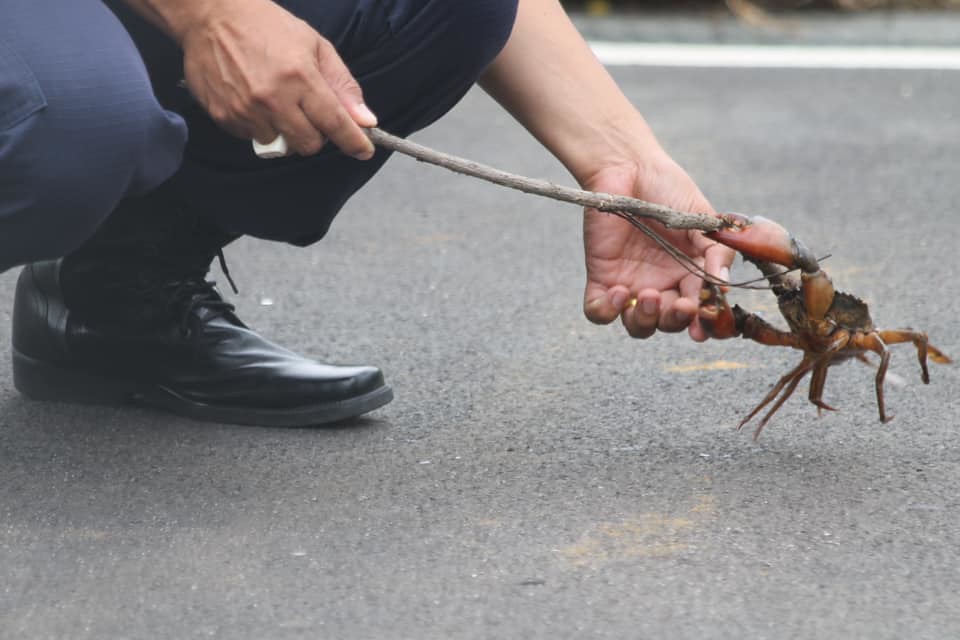The EEC Committee has passed on its final blueprint to the cabinet. The local population has protested, claiming it will destroy 7 communities.

A crab from the Bang Pakong River released at Government House
Source: Anchan Chaiyanw
On 6 August, 30 crabs from the Bang Pakong River were released at Government House as a symbol of protest against the EEC blueprint, passed on that day by the Eastern Economic Corridor (EEC) Committee chaired Gen Prayut Chan-o-cha. Most committee members are also in the cabinet which will soon authorize it before implementation.
The blueprint covers Chonburi, Chachoengsao, and Rayong. It is a part of the 20-year strategy to implement a gigantic economic project in the eastern part of Thailand, the region which saw the implementation of the Eastern Seaboard Development Project during Prem Tinsulanonda’s premiership in the 1980s. According to the blueprint, land will be divided into 4 categories: urban, industrial, agricultural, and natural conservation. The project will attract investments in 11 target industries, including automotive, robotics, and a medical hub.
However, local communities expressed concern that the blueprint has passed without their participation. On 23 July, Gunn Tattiyakul, leader of the Network of Eastern Friends, led 50 protesters from the affected areas to fight against the blueprint. “We want it green! We don’t want it purple!” said the protesters referring to colour symbol on the map which means a conservation area turned into an industrial zone.
The Network successfully pressured the EEC Committee to release the blueprint in advance, leading to the realization that it will affect 7 community and conservation areas. They came to Bangkok again on 5-6 August to protest by releasing Nile tilapia fish in a canal near the Government House, in a ceremony presided over by a monk from a temple in Rayong province. The local people claimed the farms which supply the majority of Nile tilapia fish to the national and global market come from the affected area.
The 7 areas affected by the EEC blueprint.
- Khao Din Subdistrict, Bang Pakong District, Chachoengsao Province, changes from an agricultural area to an industrial area.
- An area on the border between Chachoengsao and Chonburi provinces will be turned into Special Economic Zone for special target industries (Amata Industrial Estate 2)
- More 2,000 rai of the Bang Pakong River watershed area, Khao Hin Son Subdistrict, Phanom Sarakham District, Chachoengsao Province, will be turned into an industrial area.
- Nakhon Nayok River banks, Yothaka Subdistrict, Bang Nam Priao District, Chachoengsao Province, the use of which remains unspecified.
- A conservation forest area in the Khao Dong Yang area on the border between Plaeng Yao and Phanom Sarakham districts, has disappeared.
- An industrial area in Khao Mai Kaeo Subdistrict, Bang Lamung District, Chonburi Province, overlaps with a protected forest area and 400 households.
Pa Yup Nai Subdistrict, Wang Chan District, Rayong Province, will be turned into special economic zone without agreement between the villagers and businesses as required by law.
The Network is joined by the Enlawthai Foundation, who also criticized the fact that NCPO Order No. 2/2560 exempted the EEC blueprint from the Town Planning Act which to a certain extent protects the environment and community rights. If the blueprint passes the cabinet, they will use the evidence they have to petition the Administrative Court to suspend the EEC blueprint. The EEC is also facing challenges in the legislature. Pushed forward by the Future Forward Party, the opposition is requesting parliament to establish a committee to study the impact of the project. If successful, the project will, by tradition, be halted until the committee completes the study.

